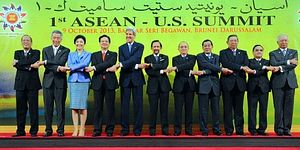On December 23, a spokesman for the White House’s National Security Council confirmed that Southeast Asian leaders had accepted an invitation from U.S. President Barack Obama to meet for a summit in the Californian resort of Sunnylands early next year.
“The President is pleased the leaders have accepted his invitation to gather at Sunnylands, in early 2016,” Myles Caggins, an NSC spokesman, said.
The 2016 meeting itself is not news. Following the last round of Asian summitry in Malaysia last November, official sources had already begun disclosing that a “special summit” between the United States and the 10 ASEAN leaders would be held in Sunnylands, with a tentative date of February 15-16 (even though U.S. officials had publicly stuck with the more cautious “first half of next year” formulation). At the time, the choice of venue received attention since this was also where Obama had met Chinese president Xi Jinping at the Rancho Mirage retreat in 2013.
Procedurally, the summit itself is not strictly new either. The United States has been having annual summits with ASEAN since 2013, part of a series of steps that the Obama administration took during its tenure to strengthen its involvement in Asian multilateralism. Indeed, as I’ve written previously, at the third U.S.-ASEAN summit held in Kuala Lumpur in November, both sides elevated their relationship to the level of a strategic partnership (See: “US, ASEAN to Ink New Strategic Partnership”).
Nonetheless, holding a summit in Sunnylands in 2016 is significant. Coming on the heels of the declaration of a new strategic partnership last November, holding the first ever standalone U.S.-ASEAN summit meeting in the United States is yet another clear sign by the Obama administration that it is serious about its commitment to ASEAN.
“[T]he upgrade of our relationship to a strategic partnership and the invitation of President Obama for all ten ASEAN leaders to come to the United States this year are perfect examples of how we have increased our engagement in the Asia Pacific pretty dramatically and have set a new – what we call a new normal,” Nina Hachigian, the U.S. ambassador to ASEAN, told reporters earlier this month in a briefing (See: “US in ‘New Normal’ With Asia Under Obama: Top Diplomat”).
More generally, continuing the momentum of U.S.-ASEAN relations into 2016 and following through on the steps outlined as part of the new strategic partnership will also be important to prove that there is substance behind the elevated relationship.
































